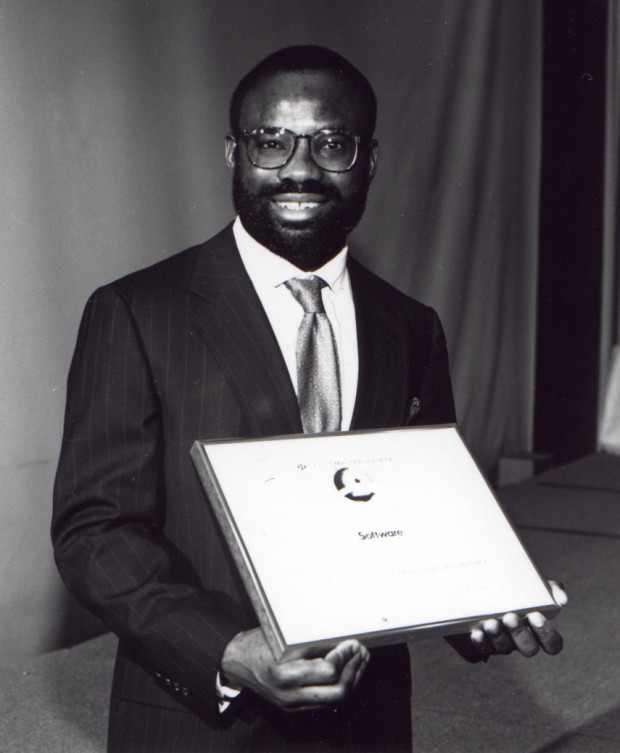|
PHILIP EMEAGWALI, a Ph.D. candidate in U-M's Department of Civil Engineering and Program in Scientific Computing, has won first place in the 1989 Gordon Bell Prize Competition, known as the annual "supercomputer olympics." Emeagwali received the award on February 28, 1990, at the Institute for Electrical and Electronics Engineers (IEEE) CompCon conference in San Francisco. The $1000 prize recognizes outstanding achievement in the use of supercomputers to solve significant scientific and engineering problems. The IEEE competition is considered the annual high point of supercomputer research. Each year, the winning works makes headlines in several publications, and the winning supercomputer is declared the "fastest supercomputer on earth."
Emeagwali conducted his award-winning work in
petroleum reservoir simulation on Connection Machine
supercomputers at the Los Alamos National
Laboratory, the National Center for Supercomputer
Applications at the University of Illinois, and the
Thinking Machines Corporation. He accessed the
supercomputers over the Internet from local
workstations.
Emeagwali's primary research interests are parallel computation and large- scale problems in computational fluid dynamics. His award-winning research focuses on underground petroleum recovery through high-speed supercomputer simulations. Background of the StudyIn 1988, the cost of imported oil accounted for 29 percent of the United States trade deficit. This fact, coupled with the drive toward less dependence on imported oil, makes it important to maximize the amount of oil recovered from petroleum production wells. Currently, engineers can only recover about 30 percent of the oil in a petroleum reservoir. Engineers can recover more oil by using petroleum reservoir simulation models to manage a group of oil wells economically.Because supercomputers are often used to solve the equations used in petroleum reservoir simulations, it is not surprising that 10 percent of supercomputers in existence have been purchased by the petroleum industry to conduct simulations aimed towards increasing the total amount of recoverable oil. Given the huge economic benefits to be derived and the fact that more powerful supercomputers are needed for accurate reservoir simulation, such simulations have been designated by the U.S. government as one of the 20 national Grand Challenges in science and engineering. Connection Machine SupercomputerThe Connection Machine, one of the fastest supercomputers ever built, consists of a collection of more than 65,000 separate processors cooperating simultaneously to solve single, complex problems. The Connection Machine is ideal for applications that require the simultaneous performance of thousands and even millions of simple arithmetical operations. For such computation-intensive applications, the processing power of the Connection Machine actually increases as the amount of data increases.ChallengesThe Connection Machine simulation of petroleum reservoirs poses several mathematical and programming challenges:
Currently, few algorithms are suitable for the architecture of supercomputers like the Connection Machine. This means that only a few complex, real-life problems can be solved on such machines. Many other problems would be potentially solvable if appropriate algorithms could be developed. To use the newer supercomputers effectively, researchers must rewrite and reformulate many computation-intensive applications. New architectures will stimulate the development of new problem-solving approaches, new governing equations (or descriptions) for important problems, and new numerical algorithms. Emeagwali designed a suitable algorithm for petroleum reservoir simulation by modifying a set of governing equations developed in 1938 by the Russian mathematician B. K. Risenkampf. Although these equations were abandoned for various historical and computational reasons and have never been used in any serious applications, Emeagwali argues that they are suitable for the newer supercomputer architectures such as that of the Connection Machine. More importantly, his approach is also applicable to a wide range of important scientific and engineering problems, including the problem of calculating the movement of buried nuclear wastes.
Another challenge associated with the use of the Connection Machine is the time spent in inter-processor communication, which has made it extremely difficult to obtain very high performance. Emeagwali was able to reduce inter-processor communication time drastically by creating and using more than 8 million virtual processors instead of the original 65,000 processors.
ResultsUsing this new approach in combination with the Connection Machine, Emeagwali's model ran at the exceptionally speed of 3.1 billion calculations per second --- twice the speed of the 1988 Gordon Bell Prize winning entry and 24 times faster than the 1987 winner. The speed of Emeagwali's model even exceeds the theoretical peak calculation speed of much more expensive conventional supercomputers, including the widely used $30 million Cray Y-MP.Running at such high speeds, petroleum reservoir simulation problems that formerly took several hours to solve on conventional supercomputers can now be solved in only a few seconds. In fact, the implementation of Emeagwali's new approach on the Connection Machine supercomputer took the petroleum reservoir simulation problem from the "I wish I could ..." stage to the "I can see how to do it" stage.
Research BackgroundEmeagwali will soon receive his Ph.D. degree in Civil Engineering and Scientific Computation from U-M. He was a civil engineer for the U.S. government before he accepted a doctoral fellowship from the University of Michigan in 1987. Emeagwali received two M.S. degrees in Engineering from George Washington University, an M.A. in Mathematics from the University of Maryland at College Park, A B.S. in mathematics from Oregon State University, and a General Certificate of Education from the University of London.
Computing News, (a University of Michigan publication) April 16, 1990 

Click on emeagwali.com for more information.
|

 Philip Emeagwali at the award ceremony
Philip Emeagwali at the award ceremony
